By Kathryn Dolan, Chief Public Information Officer | Office of Communication, Education & Outreach
This past year, news anchors, live shot reporters, and photojournalists across the state captured court hearings like never before in Indiana. Likewise, certain attorneys, defendants, witnesses, and others central to proceedings found themselves facing not only their day in court, but also media attention. While the cases garnering press camera coverage varied widely, one aspect remained the same. In all instances the judge was the key decision maker on what to allow and what to prohibit.
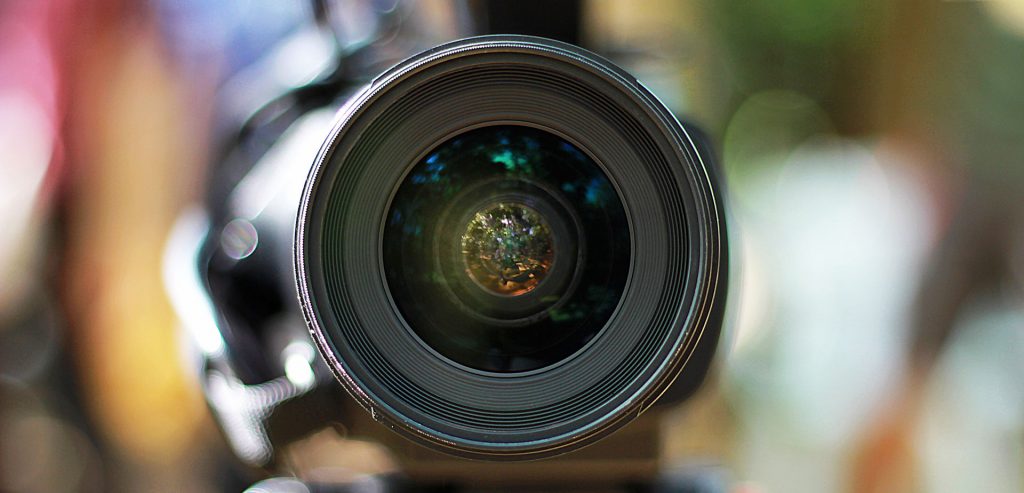
It’s been one year since judges were granted the discretion to allow news media cameras in courts, and since then, both courts and media are still getting used to the rule change. Delaware County Judge Judi Calhoun explained, “The safeguards are in place, and I like the initiative. I will decide media permissions on a case-by-case basis depending on the matter at hand.”
At the one year mark, the Supreme Court’s Office of Communication, Education, and Outreach surveyed press and judges across the state to gather information useful for future trainings. One radio station surveyed admitted, “It’s a strange feeling to be in court with a camera, but it allows the public firsthand information and that’s important.”
I am grateful that the rule allows judges to have discretion.
Judicial survey respondent
The shift in how press cover courts is tremendous for the cases where cameras are allowed, but the overwhelming majority of cases remain without press camera attention. The rule requires judges to notify parties to the request for a camera in court. In this first year, according to Odyssey case records, press coverage included 255 requests (158 listed as granted and 59 denied). By way of comparison, approximately more than one million new cases are filed in Indiana trial courts each year.
The survey of press and judges indicates overall positive reactions to the initiative, with 43 responses from media and 67 responses from judicial officers. Of those surveyed, 88% of press and 85% of judges described the initiative so far as “good” or “great.”
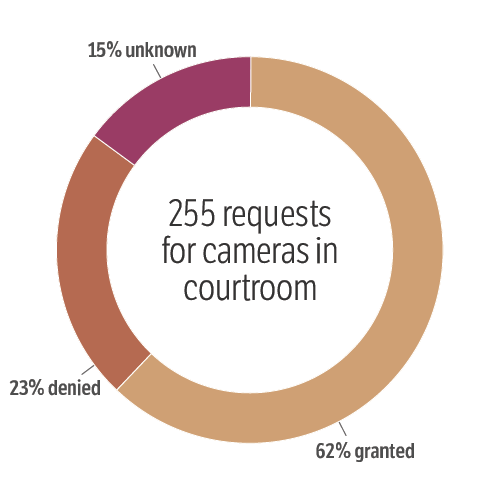
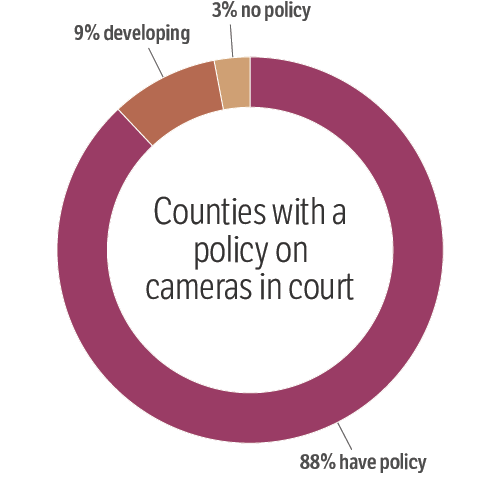
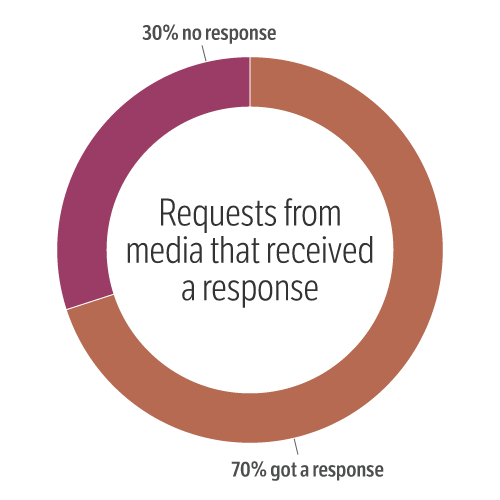
One judge said, “I believe that we are heading in the right direction with this initiative. The more transparency the better.” A press representative said, “We appreciate the cameras in the court initiative. While as a newspaper we have used it less than broadcast media, it is a vitally important part of transparency and informing the public, allowing them to better understand and see our judicial system in action.”
As with any new initiative, there are growing pains. In one instance, two jurors were briefly and unintentionally shown on a live television stream during pool coverage of a verdict announcement. The pool station explained, “They were caught on the edge of the screen before they sat down.” Media quickly acknowledged the rule violation, apologized, and worked to ensure no unauthorized footage was used. “We apologized and have had internal discussions about preventing this from happening again by shooting the defendant or judge on a tighter shot as the jury comes and goes from the courtroom.”
Judges still articulate concerns about managing non-authorized parties (like First Amendment Auditors) or press logistics. One central Indiana judge explained, “I have found my attention divided from the presentation of evidence. When there are no cameras, I can focus completely on the evidence as it is presented. With cameras, I have to turn my attention during the presentation of evidence to ensure that the media is following my directions. Just one more responsibility added upon us. I am sure that with the passage of time, the distraction to me will diminish, but that is something for consideration.”
For Washington County Judge Larry Medlock multiple cases are underway and attracting media requests:
So far, the media have been respectful of the rules and the parties involved. I think that it has been a benefit for the media to be involved in order to enlighten the public as to what is going on in their communities. It seems the media and the public don’t always understand why something is done and they question or disapprove of the outcome. If the media could explain the procedural mechanisms better, I think the public would have a better understanding of why something was done.
Medlock and other judges who have worked with press to coordinate logistics said they will help with training needs for others across the state. The Indiana Professional Chapter of the Society of Professional Journalists, Indiana Broadcasters Association, and Hoosier State Press Association remain committed to continuing education for media.
The more transparency the better.
Media survey respondent
There are some media markets where judges have a policy in place to handle requests—or are working on one—but say it doesn’t appear needed. “I love the concept and the opportunity to ‘pull back the curtain’ for the public. Sadly, our media partners in my area are completely uninterested. I have reached out to each directly, to no avail.”
Press are interested in more uniform practices in court policies. For example, one journalist replied to the survey with this observation, “I would really like to see consistency across the state in how to submit a request. Some counties had a specific form that wasn’t easy to find, some would accept an email and others had me FAX a request and then responded via email. It would be great to have some consistency in how to file a request.”
Cameras in court are ‘a vitally important part of transparency and informing the public, allowing them to better understand and see our judicial system in action.’
Media survey respondent
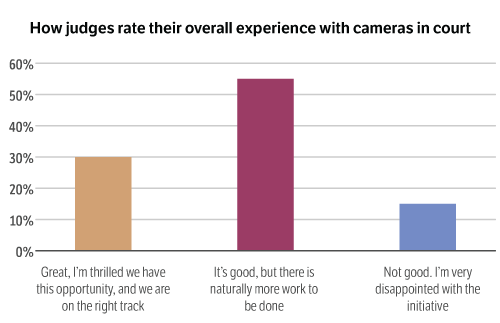
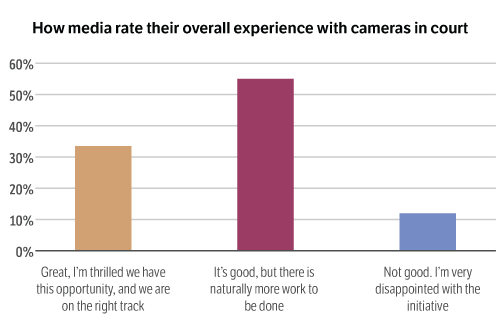
For a state with a non-unified court system, there are many challenges to creating any sort of one-size-fits all policy. The Office of Judicial Administration has developed a best practices guide, which includes useful information for both courts and media. With so many factors to consider, one judge reiterated a key aspect of the rule: Tippecanoe County Judge Kristen McVey said, “I think it is good that the discretion to grant or deny is left to the judicial officer given all the different possible scenarios, facts and circumstances that weigh on the decision to grant or deny with respect to the right of all to have a fair trial.”
For both judges and press, the overwhelming majority of survey comments included the hope that providing access allows for public understanding. One hesitant judge explained, “I am still in favor of allowing media into the courtroom. I say that because I am concerned that many in the public have a misguided understanding of what actually happens in court and an overall distrust with government. Transparency, I hope, improves the public’s understanding of our decisions and the process.”
67 judicial officers in 36 counties responded to the survey:
Adams
Allen
Bartholomew
Boone
Clark
Clinton
Dearborn
Delaware
Elkhart
Floyd
Fountain
Hamilton
Hancock
Howard
Huntington
Jasper
Jay
Jennings
Johnson
Lake
LaPorte
Madison
Marion
Pulaski
Putnam
Ripley
Shelby
St. Joseph
Steuben
Tippecanoe
Tipton
Vanderburgh
Warrick
Washington
White
Whitley
43 press from 23 media organizations responded to the survey:
14 News (Vanderburgh)
21Alive News (Allen)
93.1 WIBC and Network Indiana (Marion)
ABC57 News (St. Joseph)
CBN News (national)
Daily Reporter (Hancock)
FOX 59/CBS 4 (Marion)
Indy Politics (Marion)
KPC Media (Allen)
NBC News (national)
The Republic (Bartholomew)
WAVE (Louisville)
WBIW (Lawrence)
WDRB Media (Louisville)
Western Wayne News (Wayne)
WEVV-TV (Vanderburgh)
WHAS-11 News (Louisville)
WISH TV (Marion)
WLKY (Louisville)
WRTV (Marion)
WSLM RADIO (Washington)
WTHR-TV (Marion)
WXIN-TV (Marion)
Suggested improvements from media:
- Provide a uniform, statewide online request system instead of paper forms
- Accept email submissions instead of requiring FAX (a 60-year-old technology)
- Grant access for all hearings in a case instead of one at a time
- Develop a policy for handling requests in which advance notice isn’t possible
- Respond to every request; don’t ignore requests
- Approve more requests and/or be more consistent with approvals
- Provide detailed explanations for why requests are denied
- Only deny cameras if there is a compelling reason (e.g., minor in court, victim request)
- Allow cameras especially when it is a high-profile case
- Provide instructions on integrating cameras with existing media equipment in the courtroom